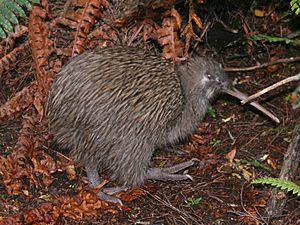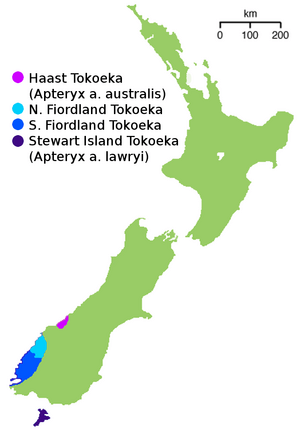Southern brown kiwi facts for kids
Quick facts for kids Southern brown kiwiTemporal range: Pleistocene-recent
|
|
|---|---|
 |
|
| Stewart Island tokoeka | |
| Conservation status | |
| Scientific classification | |
| Genus: |
Apteryx
|
| Species: |
australis
|
| Subspecies | |
|
A. a. lawryi (Rothschild, 1893) |
|
 |
|
| The distribution of southern brown kiwi | |
The southern brown kiwi, also known as tokoeka or common kiwi (Apteryx australis), is a special type of kiwi bird. It lives on New Zealand's South Island. Before 2000, many people thought it was the same species as the North Island brown kiwi.
Contents
About the Southern Brown Kiwi
The scientific name Apteryx australis comes from Greek and Latin words. Apteryx means "without wings," and australis means "from the south."
The southern brown kiwi is part of the kiwi family. It is a ratite, which is a type of bird that cannot fly. Like all ratites, it has a flat breastbone and a special kind of mouth structure.
There are two main groups, called subspecies, of the southern brown kiwi:
- A. a. australis: This group is also called the South Island brown kiwi. About 7,000 of these birds live on the South Island of New Zealand. A small group near Haast is called the Haast brown kiwi. These are very rare, with only about 250 left. They have reddish-brown feathers.
- A. a. lawryi: This group is called the Stewart Island brown kiwi. It is quite common, with about 20,000 birds living on Stewart Island. Their feathers have reddish-brown streaks.
What They Look Like
Southern brown kiwis do not have a special gland that birds use to oil their feathers. Their feathers are also different from most birds. They have long, stiff hairs, like whiskers, around their mouth. They do not have a tail, only a small bone where a tail would be.
These birds are about 45 to 55 centimeters (18 to 22 inches) long. Females are heavier, weighing from 2.1 to 3.9 kilograms (4.6 to 8.6 pounds). Males weigh from 1.6 to 2.8 kilograms (3.5 to 6.2 pounds). Their beak is long, thin, and curves slightly downwards.
Like other kiwis, they are nocturnal, meaning they are active at night. Their feathers are reddish-brown and often have streaks.
Behaviour
How They Communicate
Southern brown kiwis use their voices to protect their home areas. They also sing songs together. The male makes a high-pitched "kee-wee" sound, and the female makes a rough "kurr kurr" sound. Males call more often. When they call, they stand tall with their legs stretched out and their beak pointing up.
What They Eat
The southern brown kiwi has a long, thin beak with nostrils at the very tip. This gives them an excellent sense of smell. They use their sense of smell more than their sight or hearing to find food. They dig in the dirt for small creatures without backbones, called invertebrates. These include earthworms, beetle larvae, snails, spiders, centipedes, and grasshoppers. They do not eat much plant material.
Life Cycle and Reproduction
Female kiwis have two working ovaries, but only one tube (called an oviduct) for eggs to pass through. Southern brown kiwis are monogamous, meaning they stay with one partner. Once they find a partner, they defend their home area with warning calls. Their territory can be between 4.9 and 43 hectares (12 and 106 acres).
They build their nests in burrows or under thick plants. The female usually lays one or two eggs, but most often just one. The male kiwi sits on the egg for about 90 days to keep it warm until it hatches. After only a few days, the chick leaves the nest and finds its own food. However, it might stay near its parents for up to a year. When they are not sitting on eggs, kiwis rest alone in safe spots on the ground.
Where They Live
| Location | Number of Birds | Year | Trend |
|---|---|---|---|
| Stewart Island | 20,000 | 1996 | Stable (staying the same) |
| Fiordland | 7,000 | 1996 | Decreasing (going down) |
| Haast | 300 | 2008 | Increasing (going up) |
| Total (New Zealand) | 27,000 | 1996 | Declining (going down overall) |
Southern brown kiwis live on the South Island and Stewart Island. On the South Island, they are found in Fiordland and Westland. They live in forests, grasslands, and areas with thick bushes. The denser the plants, the better. They are very common on Stewart Island, where they also live on sand dunes.
Conservation Efforts
In 2000, the IUCN listed the southern brown kiwi as a Vulnerable species. This means they are at risk of becoming endangered. In 1996, there were an estimated 27,000 kiwis.
Some animals are a threat to kiwi eggs and chicks. Brush-tailed possums and stoats (a type of weasel) eat kiwi eggs. Stoats and cats also eat young kiwi chicks. Adult kiwis are also in danger from dogs, ferrets, and brush-tailed possums. The kiwi population on Stewart Island is stable because there are fewer of these predators there. However, stoats might have arrived on the island around 2000.
In 2018, a dry period caused problems for the Haast tokoeka, and three chicks died. Six chicks were moved by helicopter to a safe place called Orokonui Ecosanctuary near Dunedin. From there, they went to a "creche" (a safe nursery area) on Rona Island in Lake Manapouri, Fiordland.
See also
 In Spanish: Kiwi común para niños
In Spanish: Kiwi común para niños




